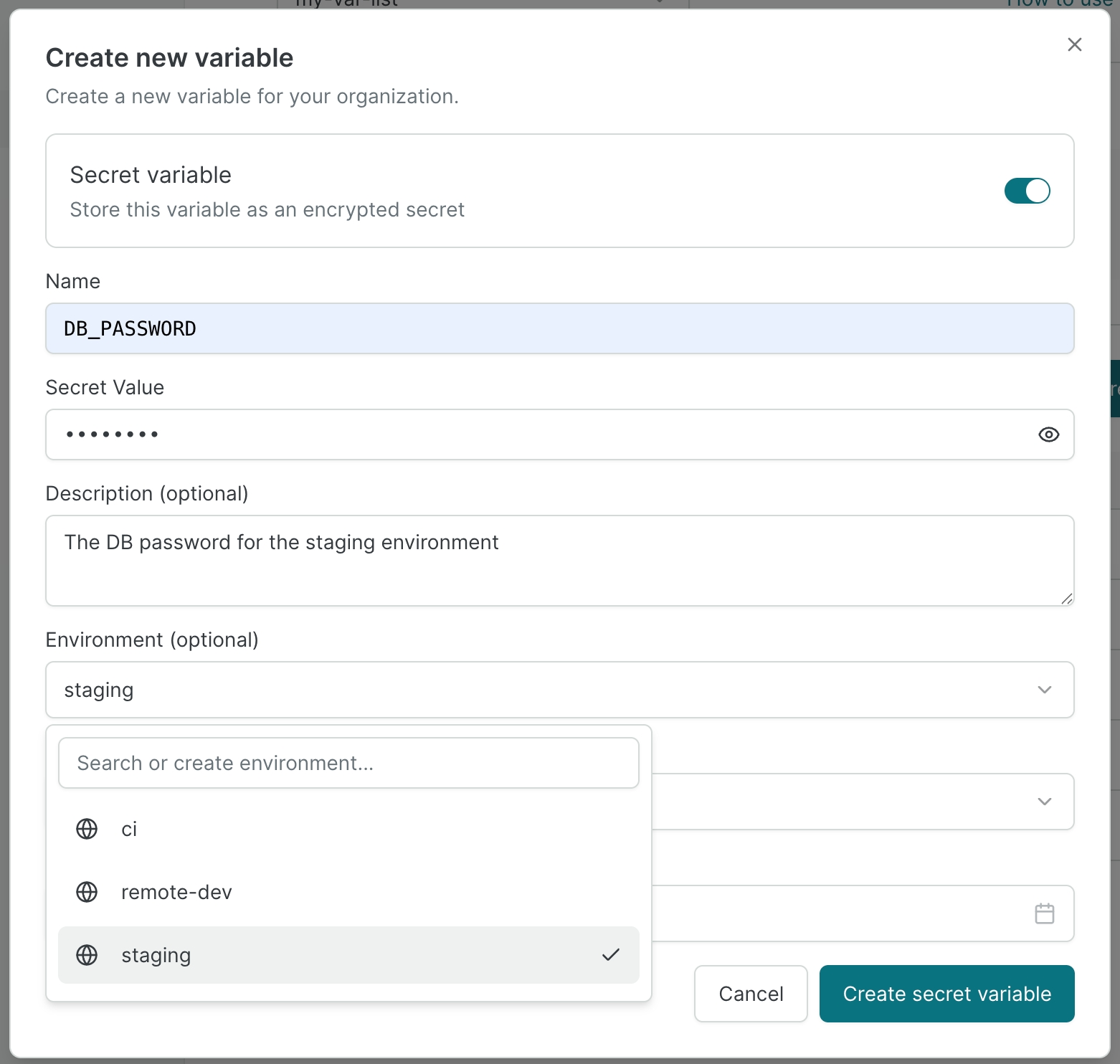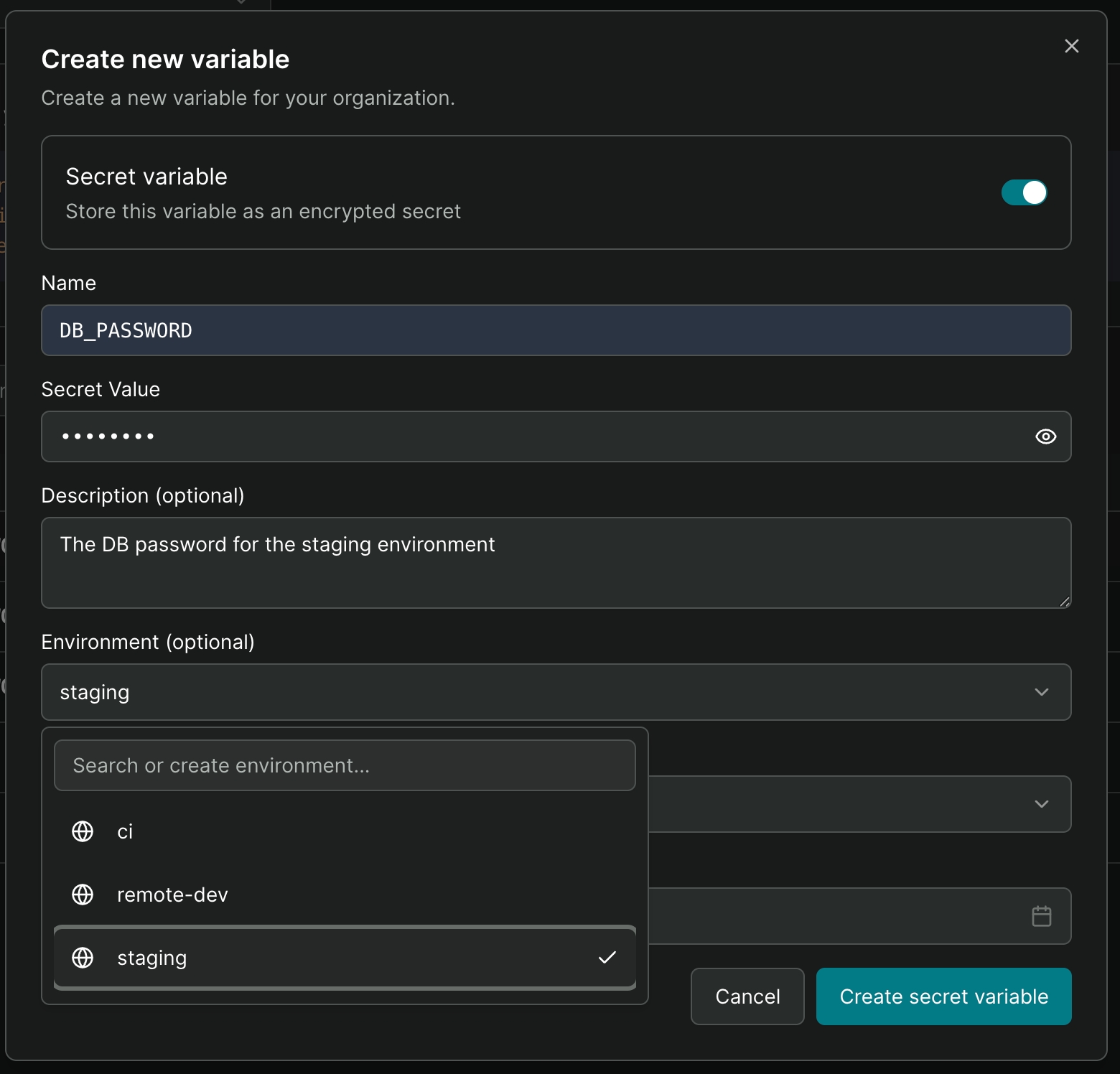Remote Variables and Secrets
Overview
The Remote Variables feature allows you to store variables and secrets securely in Garden Cloud and reference them in your Garden configuration. Remote variables and secrets can be scoped to environments and specific Garden users.
Here's a quick example before we dive into the details. Below is a screenshot of secrets stored in Garden Cloud. Notice how the secrets are scoped to different environments and users 👇


In your Garden config you can reference the DB_PASSWORD remote variable like so:
Now, if you run garden deploy --env ci (e.g. from a GitHub Action workflow), the DB_PASSWORD value will resolve to the value defined for the CI environment.
Similarly, when Lisa and Tionne run garden deploy, the value resolves to what's defined for their dev environments.
Quickstart
Step 1 — Create a variable list in Garden Cloud
Log into Garden Cloud and navigate to the variables page. If you haven't used variables in this organization before, you'll be asked to create your first variable list.
All variables must belong to a variable list. This allows you to import different sets of variables into different projects. We recommend naming the list after your project.
Go ahead and create a list and give it a description.
Step 2 — Create remote variables
Next create some variables for the list using the "Create variable" button. You can choose between secret and plain text values and optionally scope them to environments and users.
To scope a variable to an environment, select or create the environment in the pop-up dialog.


When scoping a variable to an environment, the environment name MUST match one of the environment names you have in your Garden config (under the project level environments field).
Step 3 — Import the list in your Garden project
After you've created the list and some variables, copy the config snippet from the Variables page and add it to your project level Garden configuration, under importVariables. It should look something like this:
Step 4 — Test that it works
First, make sure you're logged into Garden Cloud by running the login command from your Garden project:
Then verify that Garden can use the variables by running:
You can also do garden get remote-variables -o json for machine readable output.
You should see the variables just created in the output. If you created plain text variables, you'll see the value as well.
Step 5 — Use them in your Garden config
You can now reference the variables you created anywhere in your Garden config with ${imported.<variable-name>}. For example:
Managing access with service accounts
Variables that aren't scoped to specific users are accessible to anyone in your organization. Read on to see how to manage access by scoping variables to user and/or service accounts.
Remote secrets can contain sensitive values that not everyone in your org should have access to. You can manage access by scoping them to specific users.
A variable scoped to a user can not be used by other users. Variables that are not scoped to users will be accessible to everyone in your Garden Cloud organization. Their values aren't visible if they're encrypted but users can still use them implicitly when running Garden commands.
That's why we recommend creating a service account for secrets that should not be shared. We also recommend using a service account for CI in general, instead of running pipelines as a normal user. Here's how you create a service account and scope a variable/secret to it:
Navigate to the Users page in Garden Cloud and create a service account. Note that service accounts occupy seats just like any other user in your organization and come with build minutes.
Create a new variable on the Variables page and select the service account from the user list in the "create variable" dialog. You can also update existing variables and scope them to the service account. Note that user scoped variables must also be scoped to environments.
Create an access token for your service account from the Users page by clicking the "more" button for that user in the user list. Note it down, it's only displayed once.
You can now run Garden commands as this service account (e.g. in CI) with:
Note that anyone with admin privileges can create an access token for a given service account.
Usage examples
The examples below assume you've read the Quickstart section above and that the importVariables field is already set in your Project configuration.
Using remote variables in K8s manifests
We generally recommend using the patchResources field to override your K8s manifests as needed and this same pattern applies for remote variables. For example, this is how you'd set a remote variable as an environment variable:
For a more complete example of this approach, checkout our K8s Deploy guide
Creating remote variables with the Garden CLI
You can programmatically create remote variables via the Garden CLI.
First, get the variable list ID for the relevant list with. If you've already set the importVariables field in your project configuration, you can see the ID there.
You can also get all the variable lists with:
Or garden get variable-lists -o json for a machine readable output.
Then create your remote variables with the create remote-variables command. For example:
You can also create multiple variables at a time by passing a file of variables (dot env or JSON format) to the command. To see the different options, run:
Rotating variables that are about to expire
When creating variables you can optionally set an expiration date. For example if you create an access token in a platform you use with a three month lifetime you can include that information when creating the variable in Garden Cloud.
You can then list all the variables that are about to expire with some jq magic (assuming you have jq installed):
This will return the IDs of all variables that expire in the next two days in JSON format
You can then remove them with the delete remote-variables command:
...and re-create with updated values with the garden create variables command like we used in the example above.
Last updated
Was this helpful?

